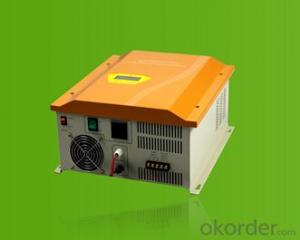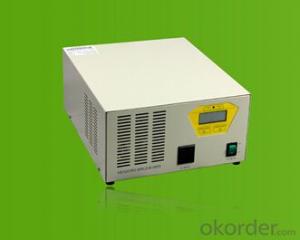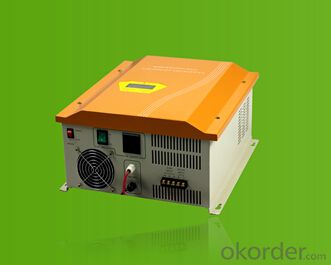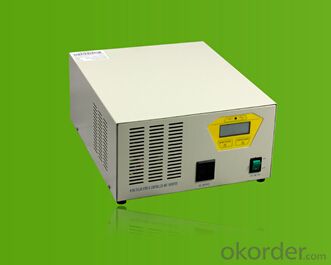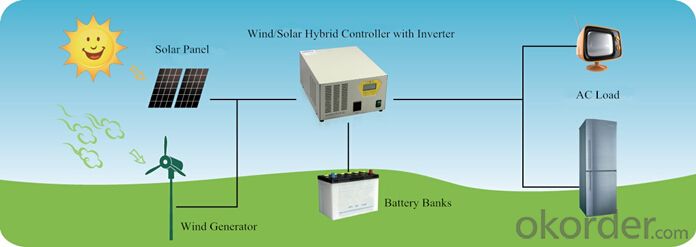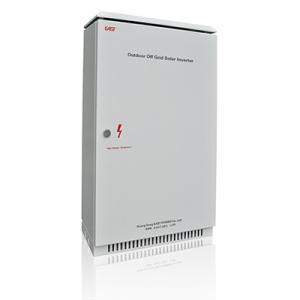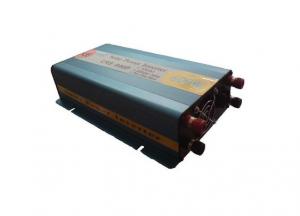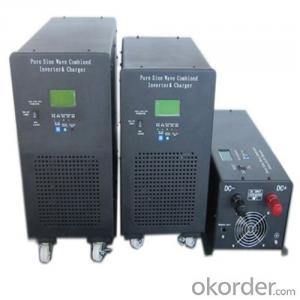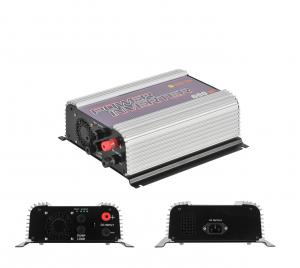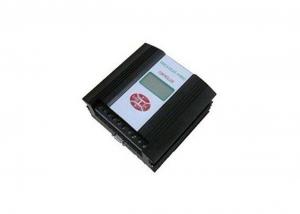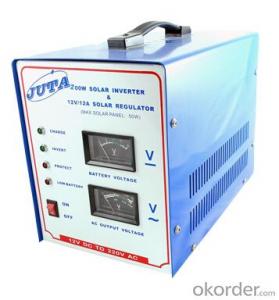600W-Wind Solar Hybrid Controller with Inverter LVRT Solar Inverter
- Loading Port:
- Shanghai
- Payment Terms:
- TT OR LC
- Min Order Qty:
- 1 unit
- Supply Capability:
- 5000 unit/month
OKorder Service Pledge
OKorder Financial Service
You Might Also Like
I. PRODUCT INTRODUCTION
Wind/solar hybrid controller with inverter is the intelligent power supply with integration of wind/solar control and DC to AC inverse. The apparatus is mainly used for wind /solar renewable energy power system; provide effective power supply for traffic inconvenience, harsh environment of mountain area, a pasturing area, border, islands and other areas without electricity. With decent appearance, easy operation, and visual indication of LCD, the controller has perfect protection function, high charging efficiency and low no-load loss.
II. PERFORMANCE FEATURES
Perfect protection function, thus the system has higher reliability.
LCD display function, visually display battery voltage and charge current.
Integrated design of controller and inverter, with simple and easy maintenance.
PWM stepless unload mode, which burn excess power into dump load, making the battery charging in the best status.
Power frequency toroidal transformer, ensures inverter has high efficiency and low no-load loss.
Pure sine wave output, compared with square wave or modified wave, has higher efficiency and higher capability of driving load.
Certificate for Invention Patent of wind/solar hybrid controller with inverter, European CE.
III. APPLICATION AREAS
Domestic household wind power and photovoltaic power system, wind power station and photovoltaic power station.
Coastal islands, remote mountainous, border posts for regions shortage of or without electricity.
Government demonstration projects, landscape lighting project.
Mobile communication base station, expressway and other non-residential regions.
IV. 600W-1KW TECHNICAL PARAMETERS
Product Mode | WWSI0606-24 | WWSI0610-24 | WWSI1010-48 |
Rated wind turbine power | 600 W | 600 W | 1000 W |
Rated solar panel power | 180 W | 180 W | 300 W |
Floating charging voltage | 29 V | 29 V | 58 V |
Dump load current | 25 A | 25 A | 21 A |
Rated inverter output capacity | 600 VA | 600 VA | 1000 VA |
Rated battery banks voltage | 24 V | 24 V | 48 V |
Over voltage shutoff | 34 V | 34 V | 68 V |
Over voltage recovery | 33 V | 33 V | 66 V |
Battery over-discharge shutoff | 21.6 V | 21.6 V | 43.2 V |
Battery over-discharge recovery | 24 V | 24 V | 48 V |
No-load loss current | ≤0.7 A | ≤0.7 A | ≤0.5 A |
Net weight | 13 kg | 16 kg | 16 kg |
dimension | 400×340×160 mm | ||
Output wave | pure sine wave | ||
Display mode | LCD | ||
Cooling | Fan | ||
Rated output power | 110/120/220/230/240 VAC | ||
Wave distortion | ≤4% | ||
Output frequency | 50/60±0.5 Hz | ||
Dynamic response | 5% | ||
Power factor | ≥0.8 | ||
Over-load capacity | 120% 1min, 150% 10s | ||
Inverter efficiency | 90% Maximum | ||
Isolating mode | frequency toroidal transformer | ||
Protection level | IP20(Indoor) | ||
Noise (1 meter) | ≤40dB | ||
Insulating strength | 1500VAC, 1min | ||
Protection functions | Battery over-charge protection; battery over-discharge protection; battery reverse connection protection; output overload protection; output short circuit protection; overheating protection; solar reverse charge protection; solar reverse connection protection; automatic brake and manual brake protection; lighting protection | ||
Working temperature | -20~+55℃ | ||
Ambient humidity | 0~93%, without condensing | ||
Working altitude | ≤4000m | ||
In order to serve our customers better. Our company can adjust parameters configuration according to customer’s requirement. | |||
- Q: What is the maximum temperature range for a solar inverter?
- The maximum temperature range for a solar inverter typically varies between -25°C to 60°C (-13°F to 140°F).
- Q: What are the different types of solar inverters?
- There are three main types of solar inverters: string inverters, microinverters, and power optimizers. String inverters are the most common and cost-effective option, where multiple solar panels are connected in a series and the inverter converts the DC power from the panels into AC power for use in the home. Microinverters are installed on each individual solar panel, converting DC power to AC power directly at the panel level. Power optimizers are installed with string inverters and optimize the output of each solar panel individually, ensuring maximum energy production.
- Q: How does a solar inverter handle voltage and frequency variations caused by grid faults?
- A solar inverter is designed to handle voltage and frequency variations caused by grid faults through a process known as grid support or anti-islanding function. When a grid fault occurs, such as a sudden drop in voltage or frequency, the solar inverter detects the disturbance and responds accordingly. To handle voltage variations, the solar inverter typically incorporates a voltage control mechanism. It monitors the grid voltage continuously and adjusts its own output voltage to match the grid voltage level. In the event of a voltage drop or spike caused by a grid fault, the inverter adjusts its output voltage accordingly to maintain a stable and safe operating condition. This helps protect both the solar system and the grid from potential damage. Similarly, the solar inverter also deals with frequency variations caused by grid faults. It constantly monitors the grid frequency and adjusts its own output frequency to match the grid frequency. If a grid fault results in a sudden change in frequency, the inverter responds by adjusting its own frequency accordingly. This ensures that the solar system remains synchronized with the grid and continues to supply power without disruptions. Additionally, solar inverters are equipped with anti-islanding protection, which means they are designed to quickly disconnect from the grid in the event of a grid fault. This is a safety measure to prevent the solar system from continuing to supply power to a faulty grid, which could pose a risk to utility workers trying to repair the fault. Overall, a solar inverter's ability to handle voltage and frequency variations caused by grid faults is crucial for the safe and efficient operation of a solar power system. By continuously monitoring the grid conditions and adjusting its output accordingly, the inverter ensures that the solar system remains in sync with the grid and provides stable and reliable power.
- Q: Can a solar inverter convert DC power to AC power during a power outage?
- No, a solar inverter cannot convert DC power to AC power during a power outage. Solar inverters rely on the grid for synchronization and voltage reference, so when there is a power outage, the inverter automatically shuts down to prevent back-feeding electricity into the grid and endangering utility workers.
- Q: What is the purpose of a solar inverter?
- The purpose of a solar inverter is to convert the direct current (DC) electricity generated by solar panels into alternating current (AC) electricity that can be used to power household appliances or be fed back into the electrical grid.
- Q: What is the maximum short-circuit current that a solar inverter can handle?
- The maximum short-circuit current that a solar inverter can handle depends on its design and specifications. However, in general, a solar inverter is designed to handle short-circuit currents ranging from 1.5 to 2 times the rated maximum output current of the inverter.
- Q: Can a solar inverter be used with solar-powered agricultural equipment?
- Yes, a solar inverter can be used with solar-powered agricultural equipment. A solar inverter is an essential component in a solar power system as it converts the DC (direct current) electricity generated by solar panels into AC (alternating current) electricity that can be used to power various equipment, including agricultural machinery.
- Q: Can a solar inverter be used in regions with high humidity or moisture levels?
- Yes, solar inverters can be used in regions with high humidity or moisture levels. However, it is important to ensure that the inverters are designed and built to withstand such conditions. Waterproof or moisture-resistant features may be necessary to protect the inverters from potential damage caused by moisture or humidity. Regular maintenance and monitoring are also recommended to ensure optimal performance in such environments.
- Q: How does a solar inverter handle voltage fluctuations during grid disturbances?
- A solar inverter handles voltage fluctuations during grid disturbances by continuously monitoring the grid voltage. When a disturbance occurs, such as a sudden drop or increase in voltage, the inverter's control system detects it and adjusts the output voltage accordingly. This allows the inverter to stabilize the voltage and ensure a consistent supply of electricity to the connected solar panels or the grid.
- Q: What is the role of a solar inverter in anti-islanding protection?
- The role of a solar inverter in anti-islanding protection is to detect when there is a loss of utility power and to disconnect the solar system from the grid. This is important to prevent the system from continuing to generate power during a power outage, which could pose a safety risk to utility workers who may be working on the grid. The solar inverter ensures that the solar system is synchronized with the grid and only operates when there is a stable utility power supply, thus providing a reliable and safe connection to the grid.
Send your message to us
600W-Wind Solar Hybrid Controller with Inverter LVRT Solar Inverter
- Loading Port:
- Shanghai
- Payment Terms:
- TT OR LC
- Min Order Qty:
- 1 unit
- Supply Capability:
- 5000 unit/month
OKorder Service Pledge
OKorder Financial Service
Similar products
Hot products
Hot Searches
Related keywords
